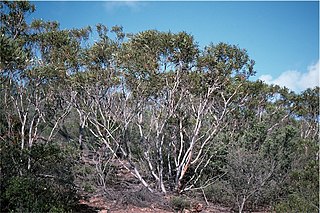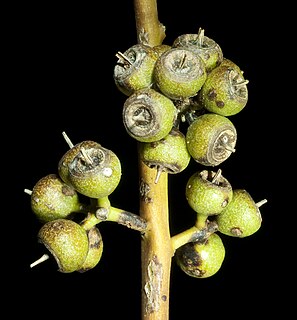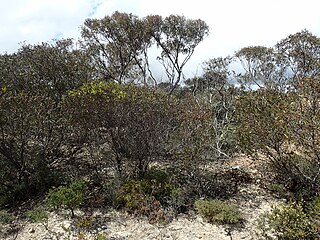
Eucalyptus conferruminata, commonly known as Bald Island marlock or bushy yate, is a small tree or mallee endemic to the south coast of Western Australia. It has smooth whitish and grey bark, elliptic to oblong or egg-shaped adult leaves, flower buds in fused in groups of between fifteen and twenty one, green to yellowish flowers and fruit forming a woody mass.
A marlock or moort is a shrubby or small-tree form of Eucalyptus found in Western Australia. Unlike the mallee, it is single-stemmed and lacks a lignotuber. It has a dense canopy of leaves which often extends to near ground level.

Eucalyptus lehmannii, commonly known as bushy yate, is a eucalypt in the myrtle family Myrtaceae endemic to the south-west of Western Australia. It is a small tree with an oval, spreading form and dense foliage which sometimes reaches to the ground. It is widely cultivated in Australia and the United States because of its ornamental shape and decorative flowers, buds and fruit. There has been some confusion about its classification because of its ability to hybridise.
Eucalyptus arborella, commonly known as Twertup mallet, is a mallet or small tree that is endemic to a small area in the south-west of Western Australia. It has smooth greyish bark, narrow lance-shaped adult leaves, flower buds in groups of thirteen to twenty fused together, yellowish green flowers, and fruits fused together in a woody mass.

Eucalyptus calcicola, commonly known as the Boranup mallee, Harry Butler's mallee or Hamelin Bay mallee, is a mallee that is endemic to a small area in the south-west of Western Australia. It has smooth, pale greenish bark, lance-shaped to curved adult leaves, flower buds in groups of seven or nine, white flowers and ribbed, cup-shaped to hemispherical fruit.
Eucalyptus exigua is a species of mallee that is endemic to Western Australia. It has smooth, whitish bark, linear to narrow lance-shaped adult leaves, flower buds in groups of between seven and eleven, white flowers and short barrel-shaped to conical fruit.

Eucalyptus latens, commonly known as narrow-leaved red mallee, is a species of mallee that is endemic to the south-west of Western Australia. It has smooth grey and coppery bark, linear to narrow lance-shaped adult leaves, flower buds in groups of seven to eleven or more, creamy white flowers and small barrel-shaped to shortened spherical fruit.
Eucalyptus litorea, commonly known as saline mallee, is a species of mallee that is endemic to a small area on the southern coast of Western Australia. It has hard, rough grey bark on the trunk, smooth grey bark above, lance-shaped adult leaves, flower buds in groups of seven, white flowers and cylindrical or barrel-shaped fruit.

Eucalyptus luteola is a species of mallee that is endemic to a small area of Western Australia. It has smooth grey bark with rough greyish ribbons near the base, linear to narrow lance-shaped adult leaves, flower buds in groups of eleven to thirteen, lemon-coloured flowers and cylindrical to barrel-shaped fruit.

Eucalyptus petrensis, commonly known as limestone mallee, straggly mallee or koodjat, is a species of straggly mallee that is endemic to Western Australia. It has mostly smooth bark, lance-shaped adult leaves, flower buds in groups of between seven and thirteen, creamy white flowers and more or less spherical fruit.
Eucalyptus quadrans is a species of mallee or a small tree that is endemic to the southwest of Western Australia. It has smooth, greyish bark, narrow lance-shaped adult leaves, flower buds in groups of seven, white flowers and cup-shaped fruit that are square in cross-section.
Eucalyptus subangusta is a species of tree, mallee or mallet that is endemic to the southwest of Western Australia. It has smooth bark, narrow lance-shaped leaves, flower buds in groups of up to nineteen, white flowers and cup-shaped to barrel-shaped fruit.

Eucalyptus talyuberlup, commonly known as Stirling Range yate, is a species of small tree or a mallee that is endemic to a small area of the Great Southern region of Western Australia. It has smooth bark, glossy green, narrow lance-shaped adult leaves, flower buds in groups of seven to thirteen, yellowish green flowers and bell-shaped to cup-shaped fruit.
Eucalyptus vegrandis, commonly known as the Ongerup mallee, is a species of mallee that is endemic to the south-west of Western Australia. It has smooth bark, linear to lance-shaped adult leaves, flower buds in groups of seven, creamy white flowers and cup-shaped or conical fruit.

Eucalyptus celastroides, commonly known by the Noongar name of mirret, is a species of eucalypt that is endemic to the south-west of Western Australia. It is a mallee, rarely a tree, and has rough bark on about half of the lower half of its tunk, smooth above, narrow lance-shaped adult leaves, flower buds in groups of seven or nine, white flowers and urn-shaped fruit.

Eucalyptus conglobata, also known as the cong mallee or Port Lincoln mallee, is a species of eucalypt that is native to the south coast of Western Australia and South Australia. It is a mallee with smooth bark, lance-shaped adult leaves, flower buds in groups of seven, white flowers and clustered hemispherical fruit.

Eucalyptus discreta is a species of shrub or mallee that is endemic to Western Australia. It has smooth creamy brown and pale grey bark, narrow-lance-shaped adult leaves, flower buds in groups of seven or nine, creamy-white flowers and barrel-shaped fruit.

Eucalyptus dissimulata, commonly known as the red-capped mallee, is a species of mallee that is endemic to Western Australia. It has smooth greyish bark that is shed in strips, glossy green, narrow elliptic to narrow lance-shaped adult leaves, flower buds in groups of between seven and eleven, creamy white flowers and short cylindrical to stubby barrel-shaped fruit.
Eucalyptus sinuosa, commonly known as octopus mallee, is a species of mallee that is endemic to Western Australia. It has smooth bark, linear leaves, flower buds fused together in clusters of between eleven and twenty-five, greenish yellow flowers and fruit that are fused into a woody mass.
Eucalyptus retusa, commonly known as the Point Hood yate, is a species of mallee that is endemic to a restricted area in Western Australia. It has smooth, greyish bark, glossy green, egg-shaped to spatula-shaped adult leaves, flower buds in clusters of between thirteen and nineteen, yellowish green flowers and fruit with their bases fused together.













